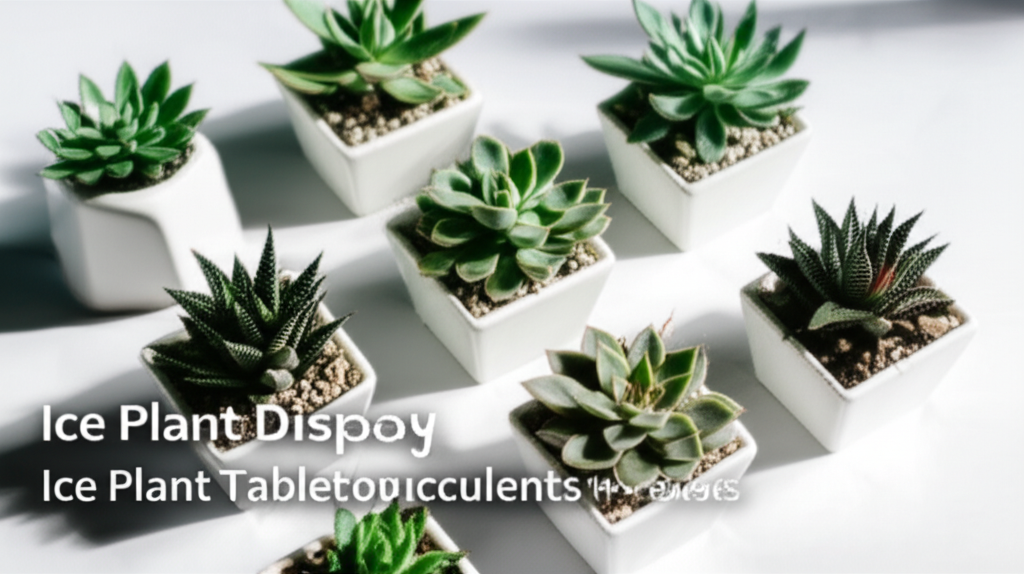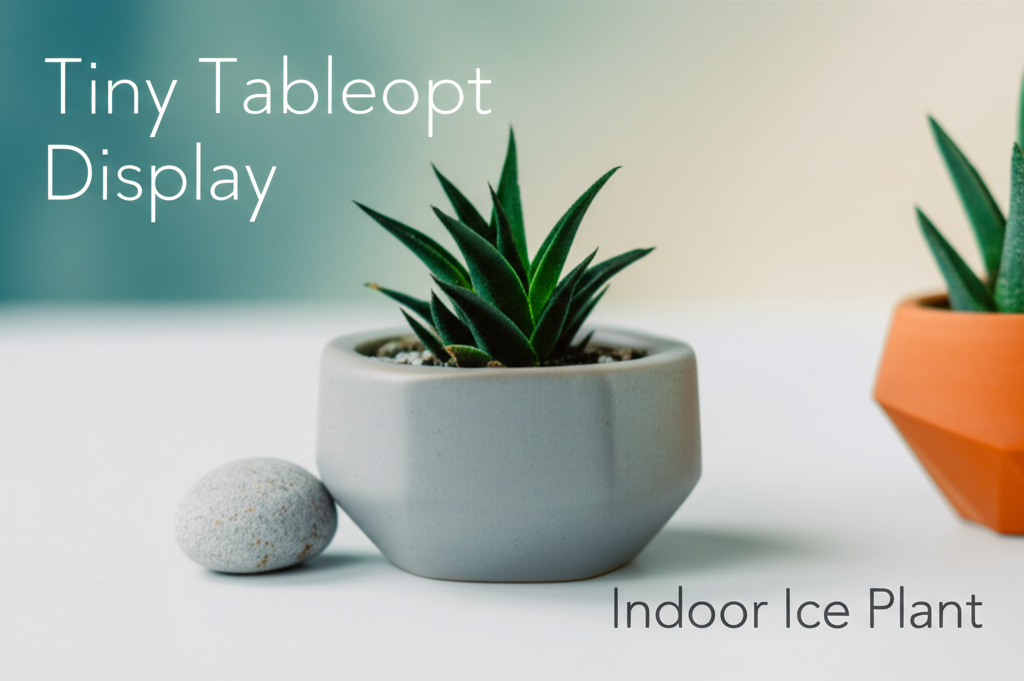The Allure of the Ice Plant Succulent for Indoor Tabletop Displays
The world of succulents offers an endless array of captivating shapes, textures, and colors, and among them, the Ice Plant succulent (family Aizoaceae) stands out for its unique charm and remarkable adaptability. Known for their jewel-like appearance, often covered in glistening, translucent papillae that resemble ice crystals, these plants bring a touch of otherworldly beauty to any space. Their typically compact growth habit makes them ideal candidates for intimate indoor tabletop displays, transforming ordinary surfaces into miniature botanical landscapes. This article will delve into the fascinating world of Ice Plant succulents, exploring their characteristics, care requirements, and offering a wealth of creative ideas for stunning indoor tabletop arrangements.
Understanding the Ice Plant Succulent
Before we dive into display ideas, it’s crucial to understand what makes Ice Plant succulents so special. Their defining feature is the presence of specialized cells called “idioblasts,” which are filled with water and capped with a transparent cuticle. These structures, often referred to as “vesicular epidermal cells” or “papillae,” reflect light, giving the plant its characteristic icy, shimmering appearance. This adaptation is believed to help the plant survive in arid environments by reflecting sunlight, reducing water loss, and even condensing dew.
Key Characteristics of Ice Plant Succulents:
- Unique Texture: The most striking feature is the presence of papillae, giving them a bumpy, bubbly, or crystalline look.
- Diverse Forms: They come in various shapes, from low-growing rosettes to more elongated forms, with species like Lithops (living stones) and Fenestraria (window plant) being popular examples.
- Vibrant Colors: While some are green, many species exhibit stunning hues of red, pink, purple, and even yellow, especially when exposed to adequate sunlight.
- Adaptability: Generally drought-tolerant and requiring minimal care, making them excellent for beginners.
- Compact Growth: Many varieties remain small, perfect for confined spaces like tabletops.
Essential Care for Thriving Tabletop Ice Plants
To create and maintain beautiful tabletop displays, understanding the basic care needs of Ice Plant succulents is paramount. They are not demanding, but a few key factors will ensure their vibrant health and appearance.
Sunlight Requirements:
Ice Plant succulents are sun-lovers. For the best color and to prevent etiolation (stretching due to lack of light), provide them with plenty of bright, indirect sunlight. A south- or west-facing window is often ideal. In lower light conditions, consider supplementing with a grow light.
Watering Needs:
Overwatering is the most common mistake with succulents. Water thoroughly only when the soil is completely dry. This might be every few weeks, depending on your climate and the pot’s drainage. Allow the soil to dry out between waterings to prevent root rot. During their dormant periods (often winter), reduce watering even further.
Soil and Drainage:
A well-draining soil mix is non-negotiable. Use a cactus or succulent potting mix, or create your own by combining potting soil with perlite or coarse sand. Ensure pots have drainage holes to allow excess water to escape.
Temperature and Ventilation:
Most Ice Plant succulents prefer temperatures between 65-80°F (18-27°C) during the day and cooler temperatures at night. They appreciate good air circulation, which helps prevent fungal diseases. Avoid placing them in drafty locations or near heating vents.
Fertilizing:
Succulents generally don’t require much fertilization. A diluted, balanced liquid fertilizer applied once or twice during the growing season (spring and summer) is usually sufficient.
Key Facts and Comparison Table

To help you choose the right Ice Plant succulents for your tabletop displays, here’s a comparison of some popular and suitable varieties:
| Succulent Variety | Key Characteristics | Ideal For Tabletop Displays | Sunlight Needs | Watering Frequency (Approx.) |
|---|---|---|---|---|
| Delosperma cooperi (Cooper’s Ice Plant) | Low-growing, spreads via trailing stems, produces bright magenta flowers. Small, bumpy leaves. | Groundcover in shallow containers, cascading arrangements. | Full sun to partial shade. | When soil is dry (every 2-3 weeks). |
| Lithops spp. (Living Stones) | Conjoined, highly adapted leaves resembling pebbles or stones. Flowers emerge from between the leaf halves. | Mimicking desert landscapes, single specimen displays in shallow pots. | Bright, direct sunlight. | Very sparingly during growth, not at all during dormancy (usually winter). |
| Fenestraria rhopalophylla (Window Plant) | Thick, fleshy leaves with translucent “windows” at the tips. Produces delicate white flowers. | Small, individual pots or mixed arrangements where its unique leaf tips can be seen. | Bright, indirect sunlight. | When soil is dry (every 2-3 weeks). |
| Cheiridopsis spp. | Fleshy, often finger-like leaves, can have colorful leaf margins. Some species produce bright yellow flowers. | Mixed arrangements, small clusters in shallow containers. | Bright, indirect sunlight. | When soil is dry (every 2-3 weeks). |
| Conophytum spp. (Cone Plants) | Tiny, often spherical or conical bodies, forming dense clumps. Many species produce star-shaped flowers. | Highly collectible for intricate, miniature arrangements, especially in tiny pots or within terrariums. | Bright, indirect sunlight. | When soil is dry (every 3-4 weeks, less in dormancy). |
Creative Indoor Tabletop Display Ideas
The beauty of Ice Plant succulents lies in their versatility for creating captivating tabletop displays. Whether you prefer minimalist elegance or a more elaborate miniature scene, there’s an idea to suit your style.
1. The Minimalist Pebble Pot
For a chic and modern look, opt for simple, clean-lined pots in neutral colors like white, grey, or black. Plant a single, striking Ice Plant succulent, such as a well-formed Lithops or a vibrant Delosperma, in a shallow terracotta or ceramic pot. Top the soil with a layer of decorative pebbles or coarse sand. This draws attention to the plant’s unique form and texture.
Materials:
- Shallow, wide pot with drainage holes
- Well-draining succulent soil mix
- Selected Ice Plant succulent
- Decorative pebbles or coarse sand
2. The Desert Oasis Terrarium
Create a miniature desert landscape within a glass terrarium. Use a mix of sand, gravel, and succulent soil for drainage. Plant a selection of different Ice Plant succulents, such as Lithops for a rocky feel and Fenestraria for its translucent tips. Add larger pebbles, driftwood, or small figurines to enhance the desert theme. Ensure the terrarium has good ventilation and avoid overwatering.
Terrarium Elements:
- Glass container (bowl, cloche, or geometric terrarium)
- Drainage layer (gravel, lava rock)
- Charcoal layer (optional, for freshness)
- Sand and succulent soil mix
- Variety of small Ice Plant succulents
- Decorative elements (driftwood, pebbles, mini figurines)
3. The Living Jewel Cluster
For a more collectible and intricate display, group several small Ice Plant succulents in tiny pots. Consider using miniature ceramic pots, thimbles, or even repurposed containers. Arrange them closely together on a tray or a decorative piece of wood. This creates a dense cluster of varied textures and colors, reminiscent of a collection of precious gems.
Clustering Tips:
- Source small, interesting pots.
- Choose succulents with different leaf shapes and colors.
- Arrange them on a decorative tray or piece of wood.
- Consider adding small stones or moss to fill gaps.
4. The Cascading Beauty Arrangement
If you have a trailing variety like Delosperma cooperi, consider planting it in a hanging basket or a pot with an elevated edge. Allow the stems to trail over the sides, creating a delicate cascade. You can mix it with other trailing succulents for a fuller effect. This adds vertical interest to your tabletop.
Cascading Ideas:
- Use pots with pronounced rims or hanging baskets.
- Plant succulents that naturally trail or branch out.
- Combine with other succulents for a mixed textural bouquet.
5. The Stone Mimicry Display
Focus on species like Lithops that are masters of camouflage. Plant them in shallow, wide containers filled with a gritty soil mix and a generous layer of small, greyish pebbles. The goal is to make the succulent blend seamlessly with its surroundings, highlighting the fascinating adaptation of mimicking stones. This is a subtle yet highly rewarding display for those who appreciate natural mimicry.
Mimicry Display Steps:
- Select shallow containers and gritty, well-draining soil.
- Choose Lithops species that match your chosen pebbles.
- Plant the Lithops so their “tops” are just above the soil surface.
- Cover the soil with matching small pebbles.
6. Mixed Bowl Arrangement
Combine several different types of Ice Plant succulents in a single, larger bowl or planter. Mix upright growers with more spreading varieties for a dynamic composition. Ensure all succulents in the bowl have similar light and watering needs. This approach allows for a greater variety of textures, colors, and forms in one cohesive display.
Mixed Bowl Strategy:
- Choose a bowl with good depth and drainage.
- Select succulents with similar care requirements.
- Arrange a focal point plant and then build around it.
- Consider variations in height and texture for visual appeal.
Troubleshooting Common Issues
Even with the best intentions, you might encounter a few issues. Here’s how to address them:
Common Problems and Solutions:
- Shriveled Leaves: Often a sign of underwatering. Check the soil moisture and water thoroughly if dry. If the shriveling is severe, the roots may be damaged.
- Mushy or Yellowing Leaves: Almost always a sign of overwatering and potential root rot. Stop watering immediately, allow the soil to dry out completely, and if possible, gently repot into dry, well-draining soil. Remove any rotten roots.
- Etiolation (Stretching): This occurs when the plant isn’t getting enough light. Move the succulent to a brighter location. You can propagate cuttings from the stretched parts.
- Pest Infestations (e.g., mealybugs): Inspect your plants regularly. Treat minor infestations with a cotton swab dipped in rubbing alcohol. For severe cases, use an insecticidal soap or neem oil.
Maintenance and Long-Term Care
To keep your tabletop displays looking their best, consider these maintenance tips:
Ongoing Care for Your Displays:
- Rotating Displays: Periodically rotate your pots to ensure all sides of the succulents receive adequate light, promoting even growth.
- Cleaning: Gently brush away dust from the leaves with a soft brush to maintain their appearance and photosynthetic ability.
- Repotting: As succulents grow, they may eventually need repotting into slightly larger containers. This is also a good opportunity to refresh the soil.
- Dormancy Periods: Be mindful of when your specific Ice Plant varieties go dormant. During dormancy, reduce watering significantly and avoid fertilizing.
Pros and Cons of Tabletop Ice Plant Displays
As with any horticultural endeavor, there are advantages and disadvantages to consider when creating indoor tabletop displays with Ice Plant succulents.
| Pros | Cons |
|---|---|
| Aesthetic Appeal: Unique textures and shimmering qualities add visual interest. | Light Sensitivity: Require ample bright light, which may not be available in all indoor spaces. |
| Low Maintenance: Generally drought-tolerant and forgiving for beginners. | Overwatering Risk: Prone to root rot if overwatered, requiring careful watering practices. |
| Compact Size: Many varieties are perfect for small spaces like tabletops. | Specialized Needs: Some species, like Lithops, have specific dormancy and watering requirements that can be tricky for novices. |
| Variety: A wide range of species offers diverse shapes, colors, and flowering potential. | Potential for Pests: Like all succulents, they can be susceptible to common houseplant pests. |
| Educational Value: Observing their unique adaptations and growth patterns can be educational. | Fragile Nature: Some delicate papillae can be easily damaged by rough handling. |
Conclusion
Ice Plant succulents offer a unique and rewarding avenue for indoor tabletop gardening. Their captivating crystalline appearance, combined with their generally low-maintenance needs, makes them ideal for adding a touch of botanical magic to any surface. By understanding their specific care requirements and embracing creative display ideas, you can transform your tabletops into miniature works of art that bring year-round beauty and fascination into your home. Whether you opt for the simplicity of a single specimen in a modern pot or the intricate charm of a desert-themed terrarium, the world of Ice Plant succulents awaits your exploration and creativity.


